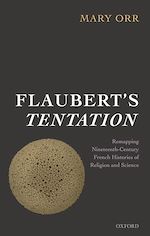
This is the first comprehensive study in English of Flaubert's least well-known masterpiece, the final version of his Temptation of Saint Anthony (1874) which, thanks to Foucault, has the reputation of being an arcane and erudite 'fantastic library' or, thanks to genetic criticism, is a 'narrative' of Flaubert's personal aesthetic ('oeuvre de toute ma vie'). By presuming instead no prior knowledge of the text, its versions or its contexts, Mary Orr provides new readings of the seven tableaux which comprise Temptation, and new ways of interpreting the work as a whole, whether the reader is a newcomer to Flaubert or a specialist.
Arguing that Flaubert was imagining his own epoch through the eyes of a visionary saint in the fourth century AD, Orr elucidates the dialogues between religion and science that are the dynamic of the work for the first time. She also insists on the meticulous accuracy and imaginative representations of the science of the work, proposing - in the 'remapping' analogy of her subtitle - that Flaubert's Temptation is a paradigm of nineteenth-century French, and indeed European, 'literary science'.
For nineteenth-century French and Flaubert specialists, this book then challenges received critical wisdom on a number of fronts. Through his unlikely protagonist-visionary, Flaubert's 'realism', 'anti-clericalism' and 'orientalism' are all given new airings in the religious and scientific evidence of the 1874 Temptation , as indeed in his 'temptation' to write the life of his times.